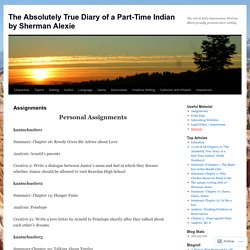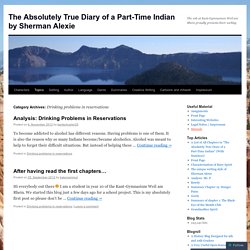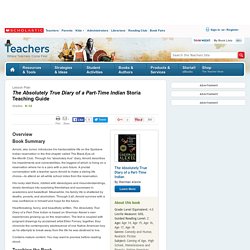The Absolutely True Diary of a Part-time Indian
> Johspa
> Books
7 history lessons that help explain the Dakota Access Pipeline protests. Oceti Sakowin camp in N.D. is the largest of three set up in opposition to the DAPL.

The campers are concerned about the pipeline, but a history of tribal land losses and worries about climate change have helped turn the opposition into a movement. CANNONBALL, N.D. — There are a lot of terms tossed around at the Oceti Sakowin camp near the Standing Rock Reservation that the outside world might not be familiar with. “Water is life,” — “Mni Wiconi” in Lakota — is the refrain from those opposed to the Dakota Access Pipeline, who call themselves “water protectors” in reference to their concerns about leaks into the Missouri River. The safety of the water supply is the immediate issue at Standing Rock, but the discussions at camp go well beyond Dakota Access. There’s talk of treaties, discovery doctrines, environmental racism and centuries of unkept promises undergirding the pipeline fight.
Aaron Huey: America's native prisoners of war.
The other residential school runaways. His name was Phillip Swain, but the people who loved that little boy never called him Phillip.

He was “Bean,” even to Mom and Dad. All these decades later, nobody quite remembers who thought up the nickname, or why it fit so well. All that’s certain is it stuck. Bean’s 12-year-old body, frozen to death, was discovered on Dec. 5, 1970—“by chance,” as a coroner later wrote. An off-duty police officer from Kenora, Ont., was hunting in a remote patch of wilderness, about 60 km from town, when he noticed a foot sticking up from the ground. Two days later—Dec. 7, 1970—a search team led by provincial police found the other missing 12-year-old: Roderick Taypaywaykejick.
Roderick’s father, James Keesick, was among the men sifting through the snow that Monday. Phillip Swain and Roderick Taypaywaykejick were Ojibwe children—and together, they had worked up the courage to run away from St. Douglas Swain, Bean’s younger brother, was five years old at the funeral.
Part-Time Indian Summer Reading Questions.pdf. The Absolutely True Diary of a Part-Time Indian: Quiz.
SparkNotes is here for you with everything you need to ace (or teach!) Online classes while you're social distancing. Find out more Further Study Full Book Quiz <p align="center"><b>This page requires JavaScript</b>, which you don't seem to have. Please try a different browser. 1. 2. 3. 4. 5. 6.
From broken homes to a broken system. Unlike in Pine Ridge and other reservations, there is no barbed wire surrounding the center.

Inside, students learn to carve in a woodshop, work out in a gymnasium and participate in “smudging,” a ceremony of burning sage and cedar to cleanse a person and keep away negative spirits and energy. The Wanbli Wiconi Tipi Youth Wellness and Renewal Center, located on the Rosebud Reservation, houses about 250 teenagers each year and is run by Miskoo Petite, who grew up in the community. “We are trying to integrate traditional Lakota cultural information, and rehabilitate our youth by bridging the gaps they might have with their identities and who they are,” he said.
Unlike other juvenile centers, where a majority of the building is used for detention, 70 percent of the space is used for programs. “I have had juveniles tell me directly that they would rather be in the juvenile detention center in Rosebud than at home,” said former Rosebud attorney general Mato Standing High.
CONVERSATIONS AT KCTS 9.
Access VG1: Audio. Incoming 9th Grade ELA The Absolutely True Diary of a Part Time Indian. The absolute diary of a part time indian questions chapter. Writing Prompts 2014. The Absolutely True Diary Of A Part Time Indian. Absolutely true diary storia tg. PR5057 AbsolutelyTrueDiary EG Redesign Final.
(Un)arranged marriage
The Absolutely True Diary of a Part-Time Indian: Discussion Questions - One Book/One New Paltz. The Truth About Trump's "Pocahontas" Slur: The Daily Show. 30 Days - Living on the Navajo Indian Reservation - OSU MediaSpace. 30 Days - Living on the Navajo Indian Reservation - OSU MediaSpace. Mrsarudi - The Absolutely True Diary of a Part-Time Indian. Welcome to "The Absolutely True Diary of a Part-Time Indian" (TATDOAPTI) Page.

Here you will find all homework assignment, projects and activities associated with TATDOAPI unit. A Letter to the Parents Please click on this link to get a better understanding of why this book should be read by your child and why we read it in 7th grade TATDOAPTI Parent Letter Here are some thoughts about the novel from others who have reviewed it.
How Hollywood stereotyped the Native Americans. Hope on the Rez. Alexiewebsite. Freshman Sherman Alexie. The Individual and Group Dynamics in Alexie?s The Absolutely True. The Absolutely True Diary of a Part-Time Indian by Sherman Alexie. Personal Assignments kantschueler1 Summary: Chapter 16: Rowdy Gives Me Advice about Love Analysis: Arnold’s parents Creative 2: Write a dialogue between Junior’s mum and dad in which they discuss whether Junior should be allowed to visit Reardan High School kantschueler2 Summary: Chapter 15: Hunger Pains Analysis: Penelope Creative 21: Write a love letter by Arnold to Penelope shortly after they talked about each other’s dreams. kantschueler3 Summary:Chapter 30: Talking About Turtles Analysis: Identity Creative 8: Write an epilogue in which you outline Junior’s development and situation five years after leaving Reardan High School. kantschueler4 Summary: Chapter 17: Dance, Dance, Dance Analysis: Love and Friendship.

Children of the Sun. Native American History. The Natives and the English - Crash Course US History #3. "The Absolutely True Diary of a Part-Time Indian". Sherman AlexieThe author's official home page.

The Absolutely True Diary of a Part-Time IndianUnit plan: essential questions, 5-week timeline, daily lesson plans, related nonfiction articles, graphic organizers, final project, assessment rubrics. 20 pages; word processor required for access. The Absolutely True Diary of a Part-Time IndianBooktalk, 8 discussion questions, and related titles for 6th grade and up. The Absolutely True Diary of a Part-Time IndianSummary, pre-reading activities, vocabulary, character analysis, discussion questions, cross-curricular and extension activities. Downloadable handouts require Adobe Reader.
The Absolutely True Diary of a Part-Time Indian by Sherman Alexie. Analysis: Drinking Problems in Reservations To become addicted to alcohol has different reasons.

Having problems is one of them. It is also the reason why so many Indians become/became alcoholics. Alcohol was meant to help to forget their difficult situations. But instead of helping these … Continue reading After having read the first chapters… Hi everybody out there. The Absolutely True Diary of a Part-Time Indian Storia Teaching Guide. Book Summary Arnold, aka Junior, introduces his hardscrabble life on the Spokane Indian reservation in the first chapter called The Black-Eye-of-the-Month Club.

Through his “absolutely true” diary, Arnold describes his impediments and vulnerabilities, the biggest of which is living on a reservation where he is a zero with a zero future. A pivotal conversation with a teacher spurs Arnold to make a daring life choice—to attend an all-white school miles from the reservation. His rocky start there, riddled with stereotypes and misunderstandings, slowly develops into surprising friendships and successes in academics and basketball.
Meanwhile, his family life is shattered by deaths, poverty, and alcoholism.
Www.randomhouse.com.au/content/teachers/tsk absolutely true diary.pdf. For ESL English Language Learners. The Absolutely True Diary of a Part-Time Indian : Sherman Alexie. The_absolutely_true_diary_of_a_part-time_indian_lessons_and_resources. The Absolutely True Diary of a Part Time Indian Trailer (2013)
Big Think Interview With Sherman Alexie. Banned Book Club: The Absolutely True Diary of a Part-Time Indian. Because Sherman Alexie writes about sexual awareness and awakening in The Absolutely True Diary of a Part-Time Indian, one could understand why parents, librarians, school administrators and even some students deem the book as inappropriate.

To suggest the book for a more mature audience might seem reasonable enough. The reality is that the main character, Arnold, is a freshman in high school and speaks in a relatable voice for young adults. The situations in the book correlate to real world experiences of high school aged people. As Alexie says, “I write books for teenagers because I vividly remember what it felt like to be teen facing everyday and epic dangers. I don’t write to protect them. Arnold is a teen boy growing up in poverty on the Spokane Indian reservation in Wellpinit, Washington. Reardan, the all white school Arnold transfers to, is 23 miles off the reservation. There’s an incredible sense of hope throughout Arnold’s story.
Kindred: "The Absolutely True Diary of a Part-Time Indian" by Sherman Alexie : CTV.
The Loss of Native American Lands Within the US: Every Year. The Absolutely True Diary of a Part-Time Indian.









